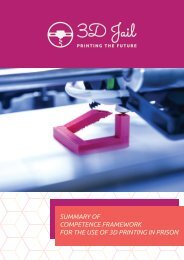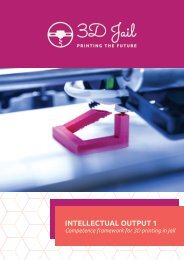Training models for the use of 3D printing technology in prison
3D Jail project further involves a training program for the training and development of trainers who are going to deliver the training program for inmates. Trainers are required to have basic computer, CAM and CAD skills. For the training of the trainers has also been planned an in-service training program to cover information on general characteristics of penitentiary institutions and inmates, use of the e-learning portal, and 3D printing.
3D Jail project further involves a training program for the training and development of trainers who
are going to deliver the training program for inmates. Trainers are required to have basic computer,
CAM and CAD skills. For the training of the trainers has also been planned an in-service training
program to cover information on general characteristics of penitentiary institutions and inmates, use
of the e-learning portal, and 3D printing.
You also want an ePaper? Increase the reach of your titles
YUMPU automatically turns print PDFs into web optimized ePapers that Google loves.
individuals from access to the Internet. Exceptionally one can find pilots in European countries where
the prison implemented a policy to allow restricted Internet access. Regardless of governmental
policy, all prisons are concerned about incarcerated individuals contacting victims, creating hidden
folders to store prohibited content and images, or engaging in criminal activity. Sometimes even
prison administrators also admit that they have concerns about staff misuse of these technologies.
Adopting advanced technologies in prison education also has costs, including short- and long-term,
and direct and indirect expenses. Although the price of computers and computer hardware has
dropped significantly in recent years, purchasing and keeping this equipment current requires funding.
Other costs include software, annual licensing fees, and vendor subscriptions. Facilities, particularly in
rural areas, also may face expenses associated with ensuring that the proper communication or
networking channels are available. In addition to funding, education, and information technology (IT),
support staff need to be trained on using and maintaining the equipment and programs, particularly
because a lack of tech savviness among staff can hinder their ability to ensure the proper use and
supervision of the technologies. Given these costs, prisons that are adopting advanced technologies
are exploring different budget approaches. Considerations include the following:
●
●
●
●
Should the prison and its education partners cover all the costs associated with the purchase,
implementation, maintenance, and monitoring of the technologies?
Should inmate welfare funds be used?
Should some of these expenses (e.g., the purchase of the computers or telecommunication
devices and software packages) be shifted to incarcerated individuals and their families? And,
if so, how will the facility environment be affected when some individuals can afford to
purchase hardware and software, and others cannot?
What portion of the cost can be mitigated by using advanced technologies to modernize and
streamline existing education and non-education services (e.g., moving from paper textbooks
to e-books, streamlining library services, and automating the monitoring of communications)?
Another challenge concerns the perceptions of policymakers, corrections officials, and the public
about whether educational technology is an appropriate, cost-effective service to provide to
incarcerated individuals. If correctional agencies are serious about preparing incarcerated individuals
for release, they cannot ignore the technological advances, including the Internet, occurring outside
of the facility walls. Some stakeholders in prison underline that security breaches will happen with
technology just as they happen in other areas in penitentiaries. They stress the importance of
addressing security breaches immediately and being transparent with corrections officials about the
breach and solution applied. Through open and honest communication about the benefits and risks
of advanced technologies in the prison education environment, a growing number of program
administrators have been able to gain the necessary support from their prison facilities and outside
funders to begin carefully adopting technology that will enable and expand learning and instruction.
Given the security and other concerns limiting the use of advanced technologies in prison education,
several approaches have been developed to provide education technology to facilities. The
approaches generally fall into the following three categories: isolated local server, point-to-point
secure line, and restricted Internet connection.
3DJail printing the future – IO2
7





